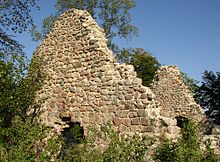Desert Church Domherrenhagen
The desert church in Domherrenhagen, a deserted area in the district of Moltzow in the Mecklenburg Lake District in Mecklenburg-Western Pomerania , is the last structural remnant of a village that existed there from the 13th to the 15th century.
history
The place name Domherrenhagen reveals the early history of the place. Due to the ending -hagen, it was a clearing settlement, which, like the nearby Marxhagen, was part of the furnishings of the cathedral monastery at Güstrow Cathedral . In 1240 the church of Domherrenhagen received 24 Hufen forest as a gift, the canons acquired another 20 Hufen. In 1271 the church became a parish church for the residents of Rambow , where there was no church at that time and which previously belonged to Schwinkendorf . In 1376 the pilgrimage to the church is mentioned in a Rostock will .
In 1458 Domherrenhagen and Marxhagen lay desolate. There are various assumptions about the causes, ranging from infertile soils to armed conflicts and epidemics. The Rostock canons then sold the arable and forest land in the village to Ulrich Moltzan, who added it to his Ulrichshusen estate , while the formerly populated area remained in the possession of the cathedral monastery. Marxhagen was settled again around 1700, but Domherrenhagen remained a desert. In 1839 the old churchyard wall was torn down.
In 1993 the churchyard wall was reconstructed and an oak alley next to the church was planted according to an old plan. In 2004 the ruin was structurally secured. Church services and concerts are occasionally held in the ruins.
The church
The church was a towerless field stone building from the early 13th century with portals and arches made of brick . The main portal was in the west, with side portals in the south and north. A sacristy was added to the north of the main building and a vestibule to the south. The church was structurally in good condition until the Thirty Years War , but then lost its roof and has been in ruins since 1648, which has been referred to as the "Desert Church" since 1648. Today only the foundations and parts of the gable walls and the connections to the longitudinal walls have been preserved.
literature
- The architectural and art monuments in the GDR, Neubrandenburg district. Berlin 1986, p. 469 (under Rambow, “Ruin of a village church”).
Web links
Coordinates: 53 ° 37 ′ 33 ″ N , 12 ° 36 ′ 51 ″ E


